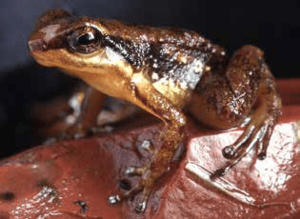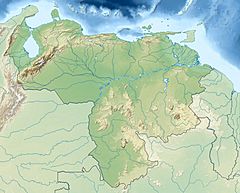Anomaloglossus breweri facts for kids
Quick facts for kids Anomaloglossus breweri |
|
|---|---|
 |
|
| Female holotype | |
| Conservation status | |
| Scientific classification | |
| A. breweri is only known from its type locality, Aprada-tepui in Venezuela | |
| Synonyms | |
|
Colostethus breweri Barrio-Amorós, 2006 |
The Anomaloglossus breweri is a special kind of frog that belongs to the family Aromobatidae. It is only found in one specific place: Aprada-tepui in the Bolívar state of southeastern Venezuela. This unique frog was discovered by scientists exploring this hard-to-reach area.
This frog moves very fast! It likes to live near small streams and quiet pools of water on the slopes of the tepui. The Anomaloglossus breweri is named after Charles Brewer-Carías. He was the person who first collected some of these frogs for scientists to study.
Contents
What Does Anomaloglossus breweri Look Like?
This frog has some cool features that make it stand out. It has a unique skin pattern and no special skin flaps (called fringes) on its fingers. Its toes have a bit of webbing, which helps it move in water.
Size and Color
The Anomaloglossus breweri also has special tongue features. Its belly is bright yellow and orange! Scientists have studied a few of these frogs. The female frog they studied was about 24 millimeters (about 1 inch) long. The largest male was around 21 millimeters (about 0.8 inches) long.
Where Does Anomaloglossus breweri Live?
This frog is only known to live in a steep, collapsed valley on the northwestern side of Aprada-tepui. This area is about 660 meters (2,165 feet) above sea level. Scientists believe it might live in more places on the tepui or nearby.
Its Home Environment
The frogs were found living along small creeks and in calm pools of water. Aprada-tepui is part of the Canaima National Park. This park helps protect the animals and plants that live there.
Why Is This Frog Important?
Even though it lives in a protected park, the Anomaloglossus breweri could still be in danger. It is only found in a very small area. This means that big natural events, like a major storm or a change in its habitat, could really hurt its population. Because of its small range, it is listed as "Near Threatened" by conservation groups.



